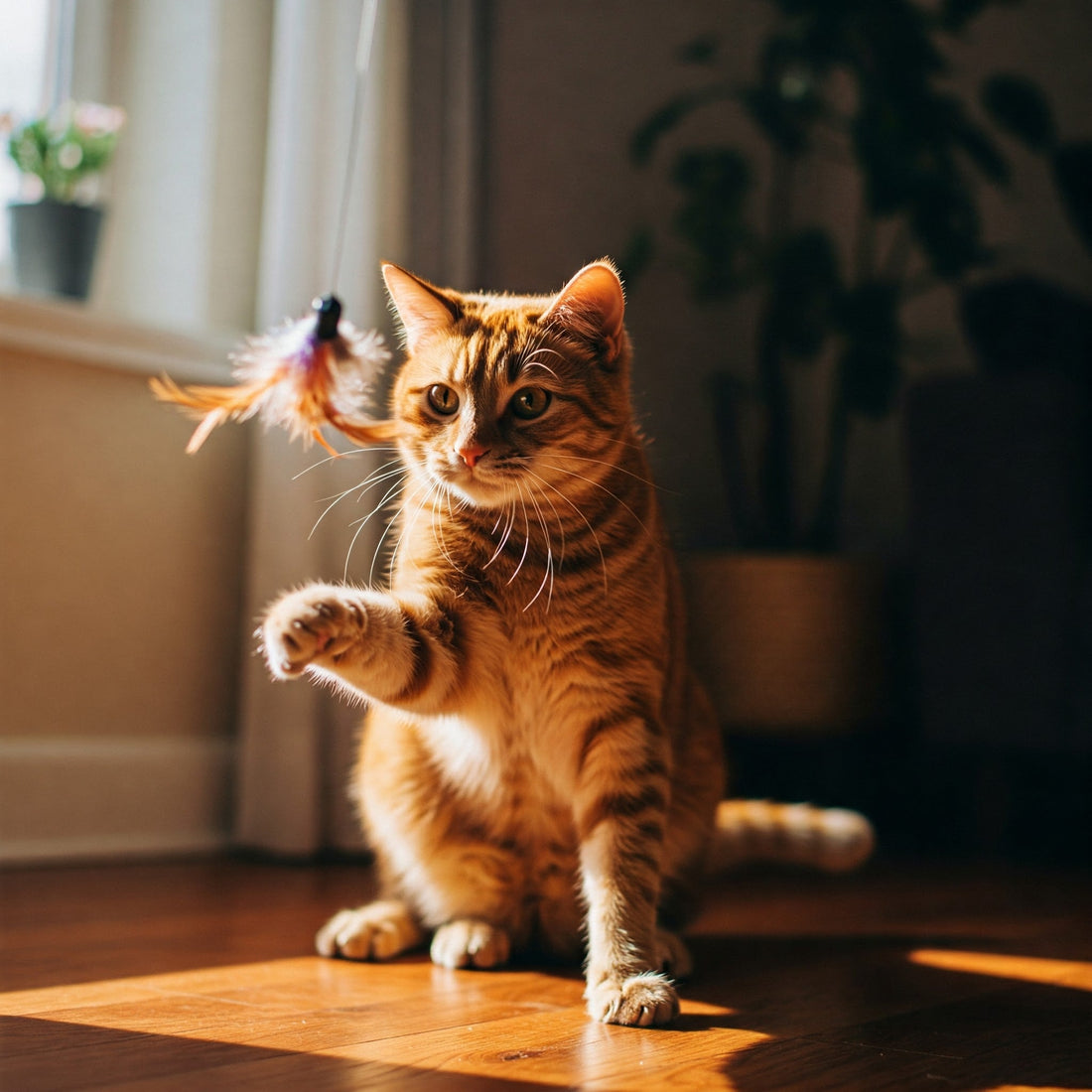
How Play Helps Reduce Cat Stress and Anxiety
Share
The twitching tail, the dilated pupils, the sudden retreat under the bed—these are the silent cries of a stressed cat, often misunderstood as mere aloofness or bad behavior. Beneath that soft fur beats a heart wired by evolution to remain constantly alert for threats, even in the safety of our homes. Modern feline anxiety stems not from prowling predators but from more insidious sources: the lonely hours of human absence, the territorial tension of neighborhood cats glimpsed through windows, the unsettling changes in routine that shake their delicate sense of security. Yet nature provided cats with the perfect stress-relief mechanism long before humans invented calming collars or pheromone diffusers—the transformative power of play. When harnessed correctly, interactive play becomes more than entertainment; it's a therapeutic tool that taps into your cat's primal instincts to rebalance their nervous system and restore emotional equilibrium.

Can Playtime Really Reduce Your Cat's Anxiety? The Science Behind Feline Stress Relief
The science behind play's anxiety-reducing effects reveals why this simple intervention works so profoundly. When your cat stalks a feather wand or pounces on a crinkly ball, their brain releases a cascade of feel-good neurotransmitters—dopamine for pleasure, serotonin for mood regulation, and endorphins for natural stress relief. This biochemical cocktail counteracts the cortisol flooding their system during anxious moments, literally rewiring their neural pathways toward calm. The rhythmic motion of play also triggers a meditative state similar to what humans experience during yoga or deep breathing exercises. Watch how your cat's pupils contract from fearful saucers to focused slits during a good play session, how their ears pivot forward in engagement rather than flattening in distress, how their breathing slows from quick pants to steady purrs. These physiological shifts demonstrate play's power to short-circuit the stress response at its source.
Different types of play address specific anxiety triggers with remarkable precision. For cats stressed by outdoor intruders they can see but not confront, predatory play sessions allow them to "hunt" and "kill" toys, satisfying that territorial frustration in a constructive way. The key lies in completing the full predatory sequence—stalk, chase, pounce, kill, eat—which is why ending play with a small food reward (like treats dispensed from a puzzle toy) provides crucial closure to the cycle. Cats suffering from separation anxiety benefit from independent play objects left strategically around the house—motorized mice that activate when you're gone, treat balls that release kibble when batted, even simple cardboard boxes arranged in a maze. These create positive associations with your absence while keeping their nervous energy productively engaged.

The timing and duration of play sessions matter as much as the activities themselves. Anxious cats often experience stress spikes at predictable times—when you prepare to leave for work, during loud household noises, or at twilight when their crepuscular instincts peak. Scheduling ten-minute play sessions just before these triggering events creates a natural buffer, allowing them to discharge nervous energy before it turns into destructive scratching or overgrooming. The play should be intense enough to get their heart rate up (mimicking the exertion of a real hunt) but always end while they're still engaged, leaving them satisfied rather than frustrated. This rhythmic regularity—play followed by grooming followed by sleep—mirrors the natural feline activity cycle that urban living often disrupts.
Multi-cat households require special play considerations to prevent competition from becoming another stress source. Parallel play stations allow cats to engage in similar activities without direct interaction, reducing tension. Wand toys with multiple attachments let you direct play away from territorial hotspots like favorite perches or litter boxes. Observant owners can use play to reinforce positive associations between feline housemates—distracting the aggressor with a toy while the timid cat passes by, or initiating joint play sessions with enough distance to prevent conflict. The goal isn't forced bonding but creating enough positive shared experiences to lower everyone's defensive vigilance.

Senior cats and those with physical limitations need adapted play that respects their abilities while still providing mental stimulation. A feather wand dragged slowly across the floor replaces leaping jumps for arthritic felines. Puzzle feeders with larger pieces challenge cognitive function without frustrating stiff paws. Even bedridden cats can enjoy "fishing" games where toys dangle within easy reach. The reduced mobility that often accompanies aging makes play even more crucial for preventing the lethargy-depression cycle that exacerbates feline anxiety. Watch for subtle signs of engagement—ear twitches, tail flicks, whisker forward—that indicate mental participation even when the body can't keep up.
The human's role in therapeutic play requires mindful presence. Unlike dogs who thrive on our boisterous participation, cats often prefer us as subtle game conductors rather than loud playmates. Your movements should mimic prey—erratic but predictable enough to maintain their interest. Avoid direct eye contact during play (a threat in cat language) and let them "win" frequently to build confidence. The tone of your voice matters too—soft, encouraging murmurs reinforce security, while sudden cheers can startle. This quiet companionship during play strengthens your bond more than any treat, giving your anxious cat a stable reference point in their unpredictable world.
Environmental enhancements can extend play's calming effects between sessions. Rotating toys weekly prevents habituation (an anxious cat's nemesis), with the "new" items being previously used toys stored out of sight. Window perches positioned near bird feeders provide passive play stimulation, while food-dispensing toys turn mealtime into cognitive exercise. Even something as simple as crumpling a paper bag before leaving the house creates an investigative opportunity that redirects nervous energy. The goal is to make their entire living space an anxiety-buffering playground rather than relying solely on interactive sessions.

Recognizing play's limitations is equally important. While immensely beneficial, play alone can't resolve anxiety stemming from medical issues, chronic pain, or severe trauma. Sudden changes in play response—avoiding previously loved toys, play aggression that doesn't subside, or excessive vocalization during play—may indicate underlying health problems needing veterinary attention. Likewise, anxious cats recovering from illness or injury may need very gradual reintroduction to play under professional guidance. Play works best as part of a holistic approach that includes proper nutrition, environmental modifications, and sometimes behavioral medication.
The true magic of play lies in its ability to meet your cat where they are emotionally. An overstimulated cat finds calming rhythm in the predictable chase of a ribbon. A depressed cat regains spark through the triumph of capturing a toy mouse. A fearful cat builds confidence by conquering increasingly challenging puzzle feeders. Unlike passive interventions like calming collars or supplements, play empowers cats to become active participants in their emotional healing—a crucial distinction for creatures hardwired for self-reliance. Those fifteen minutes of daily play become a language that tells your anxious cat what no pill or spray ever could: "You're safe here. You're capable. You're home."
